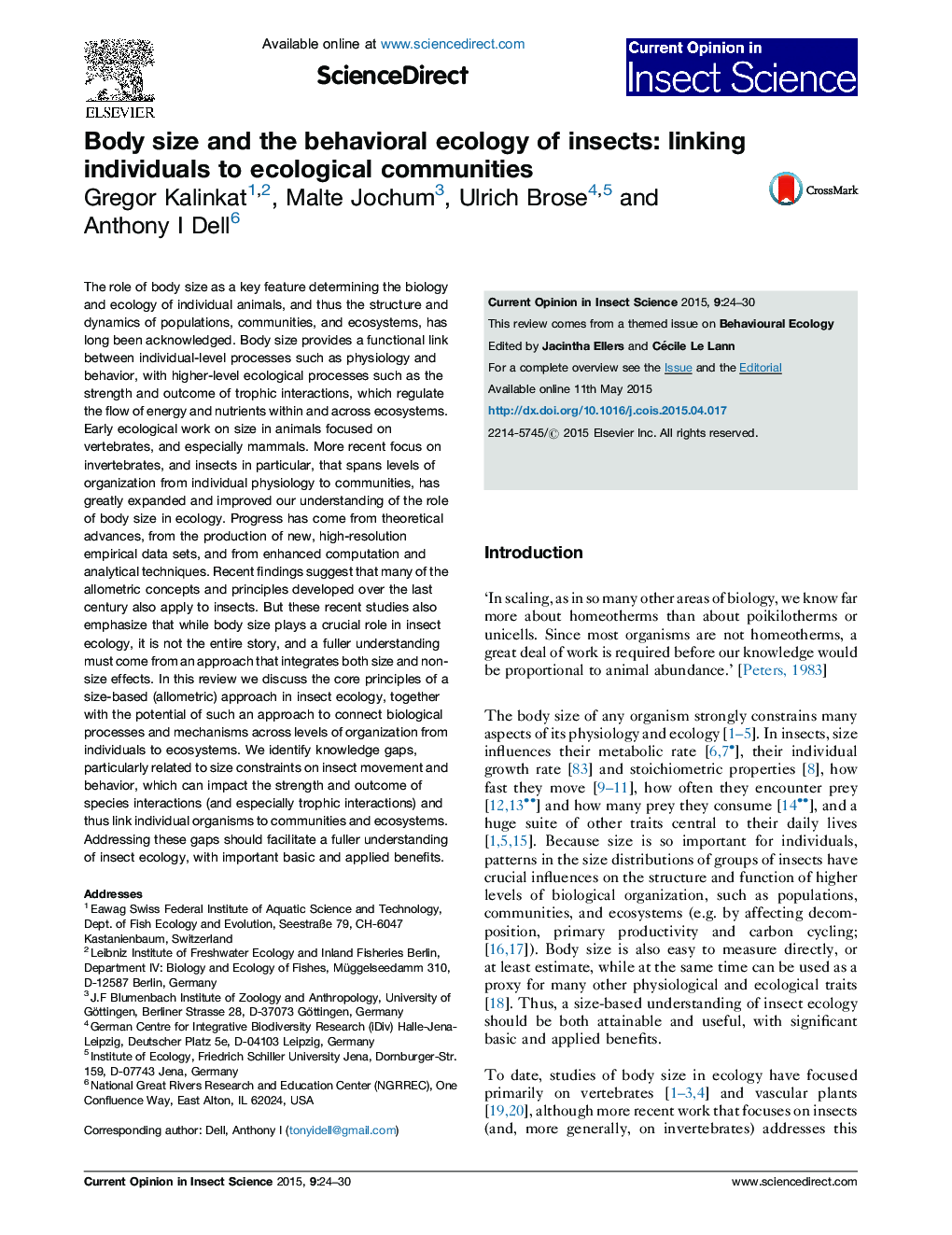| کد مقاله | کد نشریه | سال انتشار | مقاله انگلیسی | نسخه تمام متن |
|---|---|---|---|---|
| 6374164 | 1624381 | 2015 | 7 صفحه PDF | دانلود رایگان |
عنوان انگلیسی مقاله ISI
Body size and the behavioral ecology of insects: linking individuals to ecological communities
ترجمه فارسی عنوان
اندازه بدن و محیط زیست رفتاری حشرات: پیوند افراد به جوامع بوم شناختی
دانلود مقاله + سفارش ترجمه
دانلود مقاله ISI انگلیسی
رایگان برای ایرانیان
ترجمه چکیده
نقش اندازه بدن به عنوان یکی از ویژگی های کلیدی تعیین زیست شناسی و محیط زیست حیوانات فردی و در نتیجه ساختار و پویایی جمعیت، جوامع و اکوسیستم ها، به زودی شناخته شده است. اندازه بدن یک پیوند کارکردی بین فرآیندهای سطح فردی مانند فیزیولوژی و رفتار، با فرآیندهای اکولوژیکی سطح بالا مانند قدرت و نتیجه تعاملات طوفان، تنظیم جریان انرژی و مواد مغذی را در داخل و اطراف اکوسیستم فراهم می کند. کار زودرس زودرس بر روی اندازه حیوانات متمرکز بر مهره داران و به خصوص پستانداران. تمرکز بیشتر اخیر بر بی مهرگان و حشرات به طور خاص، که شامل سطح سازمان از فیزیولوژی فردی به جوامع است، به شدت گسترش یافته و درک ما از نقش اندازه بدن در محیط زیست گسترش یافته است. پیشرفت از پیشرفت های نظری حاصل شده است، از تولید مجموعه داده های تجربی جدید با وضوح بالا و از محاسبات پیشرفته و تکنیک های تحلیلی. یافته های اخیر نشان می دهد که بسیاری از مفاهیم و اصول آلومتریک در طول قرن گذشته برای حشرات نیز مورد استفاده قرار می گیرند. اما این مطالعات اخیر نیز تأکید می کند که در حالی که اندازه بدن نقش حیاتی در محیط زیست حشرات بازی می کند، این داستان کامل نیست و باید درک کاملتری از یک رویکرد که هر دو اندازه و اثرات غیر اندازه گیری را ادغام می کند. در این بررسی ما اصول هسته ای یک روش اندازه گیری (اندازه گیری همه جانبه) در محیط زیست حشرات را به همراه پتانسیل چنین رویکردی برای اتصال فرآیندهای بیولوژیکی و سازوکارها در سطح سازمان از افراد به اکوسیستم ها مورد بحث قرار می دهیم. ما شکافهای دانش را شناسایی می کنیم، به ویژه در ارتباط با محدودیت های اندازه بر جنبش و رفتار حشرات، که می تواند بر توانایی و نتیجه تعاملات گونه ها (و به ویژه تعاملات طوفیک) تأثیر بگذارد و بنابراین گیاهان فردی را به جوامع و اکوسیستم ها پیوند می دهد. رسیدگی به این شکاف ها باید درک کاملتری از محیط زیست حشرات، با مزایای اساسی و کاربردی مهم را تسهیل کند.
موضوعات مرتبط
علوم زیستی و بیوفناوری
علوم کشاورزی و بیولوژیک
علوم زراعت و اصلاح نباتات
چکیده انگلیسی
The role of body size as a key feature determining the biology and ecology of individual animals, and thus the structure and dynamics of populations, communities, and ecosystems, has long been acknowledged. Body size provides a functional link between individual-level processes such as physiology and behavior, with higher-level ecological processes such as the strength and outcome of trophic interactions, which regulate the flow of energy and nutrients within and across ecosystems. Early ecological work on size in animals focused on vertebrates, and especially mammals. More recent focus on invertebrates, and insects in particular, that spans levels of organization from individual physiology to communities, has greatly expanded and improved our understanding of the role of body size in ecology. Progress has come from theoretical advances, from the production of new, high-resolution empirical data sets, and from enhanced computation and analytical techniques. Recent findings suggest that many of the allometric concepts and principles developed over the last century also apply to insects. But these recent studies also emphasize that while body size plays a crucial role in insect ecology, it is not the entire story, and a fuller understanding must come from an approach that integrates both size and non-size effects. In this review we discuss the core principles of a size-based (allometric) approach in insect ecology, together with the potential of such an approach to connect biological processes and mechanisms across levels of organization from individuals to ecosystems. We identify knowledge gaps, particularly related to size constraints on insect movement and behavior, which can impact the strength and outcome of species interactions (and especially trophic interactions) and thus link individual organisms to communities and ecosystems. Addressing these gaps should facilitate a fuller understanding of insect ecology, with important basic and applied benefits.
ناشر
Database: Elsevier - ScienceDirect (ساینس دایرکت)
Journal: Current Opinion in Insect Science - Volume 9, June 2015, Pages 24-30
Journal: Current Opinion in Insect Science - Volume 9, June 2015, Pages 24-30
نویسندگان
Gregor Kalinkat, Malte Jochum, Ulrich Brose, Anthony I Dell,
